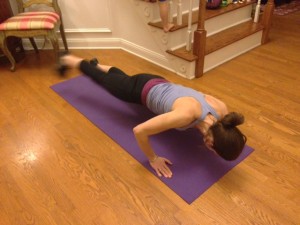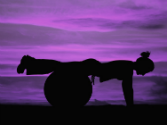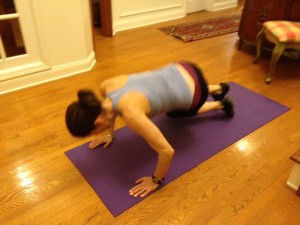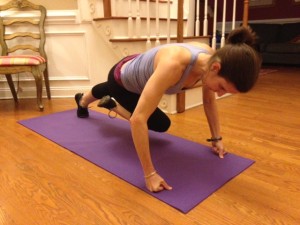Push Ups – Some New Twists to an Old Friend (and some extra core work as well)
I tried Alan’s push up routine the other day. I love push ups because they work the core and the arms without using weights or equipment. I was very surprised how difficult some of these variations on the standard push up are…try them at home!
By Alan Tyson, PT, ATC
We are big proponents of body balancing exercises and Yes most athletes need to work their upper backs more but with some guidance and variety many will benefit from this often neglected exercise. Just remember to stay balanced with your workout approach. Push Ups are one of the first exercises we learn to do. I am not sure why we abandon them as we get older (we need to bench press, we aren’t challenged enough, etc). Here are some ways to give you variety and you can take this test. Perform 10 reps of each straight through. This is also a great core workout, and remember to gently stretch your shoulders afterwards. Also, if you have a previous shoulder issue only go ½ way and you should never feel these exercises in the front of your shoulder. Good Luck and let me know how you do.
Standard Pushup
The benefit: The standard pushup works your chest, shoulders, triceps, and core.
How to do it: Kneel down on all fours and place your hands slightly beyond shoulder-width apart. Set your feet together and straighten your arms and legs. Your body should form a straight line from ankles to head. Keeping your elbows pulled in toward your sides, lower your chest to an inch above the floor, and press back up. That’s 1 rep.
Leg-Kick Pushup
The benefit: By forcing you to hold a position, it activates more muscle in your chest and shoulders than a standard pushup does. It also helps develop strength and flexibility in your hip flexors, glutes, and hamstrings.
How to do it: Assume a pushup position, and then lower your body until your chest nearly touches the floor. Kick your right leg out to the side as close to a 90-degree angle as possible without bending your knee. Pause, and move your leg back to the starting position. Push your body back up, and repeat with your left leg.
Knee-to-Opposite-Elbow Pushup
The benefit: It uses rotation to work your abdominal muscles, hip flexors, and back in addition to targeting your chest and triceps.
How to do it: Assume a pushup position, but form fists with your hands so your knuckles are flat against the floor. Bring your right knee to your left elbow, and pause before returning your leg to the starting position. Now lower your body as you would for a standard pushup. Push back to the starting position and repeat, this time bringing your left knee to your right elbow.
Corkscrew Pushup
The benefit: It works your quads, calves, and core in addition to all the upper-body muscles activated when you do a standard pushup.
How to do it: Assume a pushup position, but walk your feet toward your hands until your knees are bent at a 90-degree angle, with your hips slightly higher than your head. Lower your left side close to the floor by rotating your body and bending your elbows. Pause, and then rise slightly and rotate your right side to the floor. Pause again, and push back up to the starting position. That’s 1 rep.
Triangle Pushup
The benefit: It forces one arm to work harder to handle a heavier load, and changes the angle of movement to stimulate more muscle.

I tried to do 10 on each side…I got through about 6 on each side the first time I tried. Hopefully it’s an aquired thing!
How to do it: Assume a pushup position, but form fists with your hands so your knuckles are flat against the floor. Lower your chest to your left hand, pause, and push back up. Repeat, this time lowering your chest to your right hand. Alternate sides each rep.
Twisting Pushup
The benefit: It works the rotational muscles in your core, and improves flexibility in your hip and groin muscles.
How to do it: Assume a pushup position, but form fists with your hands so your knuckles are flat against the floor. Rotate your hips to the left and cross your right leg in front of your left. Then lower your chest toward the floor as you would for a standard pushup, being careful not to let your hips touch the floor. Push back up and return to the starting position. Repeat with your left leg.
Uchi Mata Pushup
The benefit: It increases activation of your core, lower back, and hamstrings while also boosting demand on the muscles in your shoulders.
 How to do it: From a pushup position, lift your right foot so your leg is parallel to the floor. Lower your body until your chest nearly touches the floor. Now raise your lifted leg higher into the air. Push back to the starting position. Do half your reps, switch legs, and finish your set.
How to do it: From a pushup position, lift your right foot so your leg is parallel to the floor. Lower your body until your chest nearly touches the floor. Now raise your lifted leg higher into the air. Push back to the starting position. Do half your reps, switch legs, and finish your set.
Alternating Grip Single-Leg Pushup
The benefit: It works your lower-abdominal muscles and places more demand on your chest and serratus anterior, an important posture muscle that runs from your chest and along your rib cage to your shoulder blade.
How to do it: Place your right hand in a standard pushup position, but move your left hand a few inches forward. Raise your right leg and then lower your body until your chest nearly touches the floor. Push back to the starting position. Do half your reps, then switch arms and legs and finish your set.
Kettlebell Pushup
(I don’t have two of the same sized kettlebells, so I skipped this one. Although you can use 10 lb. weights just as easily).
The benefit: It challenges your forearms, rotator cuffs, and core muscles as a result of the instability of the exercise.
How to do it: Assume a pushup position, but place each hand on a kettlebell with your palms facing each other. Lower your body until your chest nearly touches the kettlebells, pause, and then push back to the starting position.









Speak Your Mind